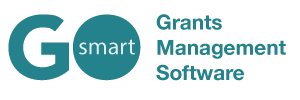There are several tools in GO Smart to assist with the FDR reporting required of pass-through funders of the National Endowment of the Arts.
- The NEA Questions Template (the 2023 updates for which are laid out in detail below)
- The Activity Locations Template
- The Project Budget Template
- The NEA Report
- The Activity Locations Report
At minimum, we recommend you use the NEA Questions and Activity Locations templates in your final report to gather the required Final Descriptive Report data for NASAA and the NEA. Our NEA questions template, along with select profile data, and optional data of the Project Budget template come together in the NEA report, making your Final Descriptive Report (FDR) compilation easier.
You can use the NEA Questions template as your single source for collecting 24 of the 28 FDR points, including demographic and budgetary information. Change the way this page works for you in future cycles by clicking the edit icon from the Grant Editor > Cycle Pages and use the new tools to determine which fields are:
- Hidden
- Displayed (but not modifiable)
- Modifiable
- Required
The page will also display data points from the profile page, and applicants can be prompted to update their profile if necessary. You can also make the DUNS, the new UEI field, and/or the FEIN fields interactive on the NEA page so applicants who may not have included this data on the profile can still provide it to you.
Click a link below for more information on how to use the NEA Tools Question template.
What you’ll see on the page editor
What your applicants will see
How the page will work in multiple forms of a cycle
What to do if you already use the NEA tools
What you’ll see on the page editor
The backend of the template contains settings that give you control over how each field works on the form. For each field, use the following toggle settings to determine how the applicant can interact with that field.
Display makes the field visible to the applicant in that form. You can show a field in later forms that was hidden in earlier forms, and vice versa.
Editable makes the field visible and allows the applicant to modify.
Required makes the field visible and obligates applicants to complete before they can submit.Hide a field from the applicant
What your applicants will see
Questions will be grouped by Profile Data, Demographics, and Financials. From Profile Data, applicants will see several data points as displayed on their profile. They will be prompted to update any necessary information in their profile. They will also be able to add the FEIN, UEI, and/or DUNS information if those fields are set as visible and editable. The demographics section will include the standard NEA questions in a multi-column layout. The financial section can include the three budget total fields, as well the grant requested, awarded, and spent fields. Grant Amount Awarded will display the amount designated on the grant manager dashboard. Similarly, budget totals will be populated by the totals of the Project Budget page. Applicants can add these amounts if you make those fields editable.
How the page will work if you use it in multiple forms of the cycle
Using this page in more than one cycle form (the application, interim report, and/or the final report) will give you control over when and how each field is available. You can link the page from one form to another which will pre-populate the data from the subsequent page into the current page. If you set a field as editable in the application and only display it in the final report, the data will be visible but not editable. If you set a field as editable in both the application and a pre-populated final report, data will be visible and can be modified.
If you include this template in multiple forms of the cycle, the most current data will pull into the NEA report. If you ask for estimates in the application and actuals in the final report, your applicant’s actuals will appear in the NEA report but you will be able to see the estimates if you review the application read-only form or pull the application NEA page in a custom report. You can determine if data provided in subsequent forms will appear as read-write or read-only data, meaning you can lock certain fields (best for amount requested) and make other fields modifiable (best for audience estimates).
What to do if you already use the NEA tools
By default, this page will set the fields to required, show, hide, etc. We recommend that you either test one of your cycles or preview your NEA pages from the Grant Editor > Cycle Pages so that you can understand what your applicants will see. We also recommend that you make use of the new tools and consider modifying your next cycle(s) to use the NEA template in the way that works best for your workflow and reporting. Contact the GO Smart team if you have questions about maximizing your use of the NEA Questions template for future grant cycles.
